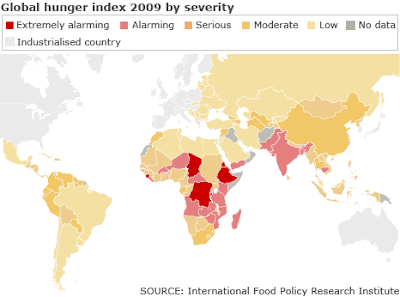I don't live in the perfect world, so there are many times when I show my imperfections, and my kids often show up my worst traits, especially when they make a show of their self-created table manners. Most times, I manage to deal with bad situations in a way that will eventuate in a happy outcome, but there was one time recently when I really lost my cool. It was Sunday, and I had made a very tasty
cauliflower soup (which I knew my daughter liked),
spinach and potato omelette (which I knew my husband liked, and my daughter would show an interest in trying) and
spanakopita (which I knew everyone liked, and my son would only choose this from all the food I had on the table).

 Hard to choose, isn't it, with so much choice available?
Hard to choose, isn't it, with so much choice available?"What would you like me to serve you?" I asked my son. Although I always know the answer to this, I still live with the hope that one day, he will surprise me.
"Well, you know I eat only one of these foods, Mum," he replied, so I gave him a piece of spinach pie without further ado.
"What would you like, dear?" I asked my daughter.
"I think I'll have the soup," she replied. "But I also want some pita, too!"
"OK," I agreed, "which will you have first?" I believe in choices at the table, but only from what is offered.
"The soup." So I ladled it out for her, and we all sat down to eat.
My son was close to finishing his pita.
"It's too hot," she said, frowning. I half-believed her; I also knew that she could see her brotgher finishing quickly, and she was probably thinking that he could be leaving the table soon to go and play with his toys.
"Hot?" her dad exclaimed. "No, it's not. If it were, then I would be complaining too, and you know I'm not, so it's not."
"Would you like the pita then, instead?" I asked helpfully. Maybe she just didn't like the soup, and she had also asked for some pie after all.
"No."
"So you want to eat the soup?" I was started to get a bit impatient.
"Yes."
"OK."
Two minutes later, after she had broken bits of bread into her bowl, the spoon was in her hand and she had not eaten not one spoonful of soup.
"If you don't want that soup, I'd appreciate it if you don't dirty it with other food, because no one's--"
"I'm going to eat the soup!" she cried out angrily.
"OK, let me watch you eat it then." (She has my stubbornness.)
She sat with her elbows on the table and her hands under her ears, one of her hands still holding that bloody soup spoon.
"Do you want some pita instead?"
"Not yet. I TOLD you I'll have it AFTER the soup!"
"If you don't start eating that soup now, then I want you to leave the table." It was Sunday, I had cooked a really good meal, and I was in the middle of enjoying some ale which I'd recently bought for the first time from a gourmet store.
She did not start to eat her soup, nor did she leave the table. Enough is enough, I thought. I picked up her plate and firmly picked her up off the chair, pointing to her room.
"Can I have the pita now?" she asked.
"No. You can have some pita in the afternoon."
"But, Mum, I'm hungry!"
"Go to your room, and stay there till I tell you!" She knew I meant it.
There is no such thing as hunger in Crete. There is poverty, but people don't starve. There is so much food growing in the fields, being prepared in everyone's houses, being sold at stores in a range of prices to suit one's pocket (discount supermarkets do a roaring trade here), that there is more than enough for everyone, and besides, Cretans have always shared their food, and they still do so. My daughter did not have lunch that day, but she had had her favorite weekend breakfast (coco plops - sic - with milk, a Kinder chocolate egg for tidying up all the bookshelves with her brother and a late morning snack of yoghurt topped with quince preserve and walnuts. She couldn't possibly be hungry. She doesn't know what the word means, and neither does her mother, even though, in both their not too distant past, all their grandparents had known it at some time in their lives. Her great-grandfather, as a soldier fighting in the Albanian wars at the turn of the century, prised a piece of watermelon rind from a mule's mouth, and shared it among the other troops in his party, to stave off their hunger. In the second world war,
many Athenians literally starved to death; their corpses were skeletons before they dropped dead in the middle of the streets of the capital.
 Greece (and therefore Crete) is considered an industrialised country. To get a better idea of Crete's location, use the map below as a guide, then compare it with the global hunger map.
Greece (and therefore Crete) is considered an industrialised country. To get a better idea of Crete's location, use the map below as a guide, then compare it with the global hunger map.
View Larger Map
Yet, just south of the Cretan borders beyond the Mediterranean ocean, and all around the northern and eastern borders of the Greek state,
people live with hunger. It is rather shocking to realise that the island of Crete borders three continents: Europe (by land), Asia and Africa (both by sea), and mainly by countries whose people have a problem getting access to food to keep themselves fed. The world seems so unfair with its uneven distribution of food among neighbouring countries.
Not only that, but Greece has recently been named as the country with the fastest rates of
obesity in children, especially in Crete. It's beyond a joke these days when people with weight problems are seen feeding their overweight kids with store-bought packaged food, creating not just weight problems but health problems in their nearest and dearest.
My greatest pet hate is to see decent food going to waste. It's just wrong, so unethical, so blatantly wasteful and unsustainable.

While enjoying a warm evening at a (cheap) pizzeria, I was astounded when the three men sitting at the table behind ours got up and left, leaving all this food on their plates: most of the salad, half the cheese and ham-covered french fries, half a bowl of pasta and a plate of thick cut fries - the worst moment was watching the waitress piling all the plates on top of each other, in full knowledge that she was about to bin this perfectly edible food. The eaters showed no sign of not enjoying the food. They just ordered it and didn't eat it.
Such food, apart from the fact that it should not have been prepared in the first place if it was going to be thrown away, could have been stored appropriately and eaten during another meal time, or it could have been shared among friends and family, or been given to a pet instead of giving it tinned petfood or crackers. But to completely bin it is simply anathema.
 Lisa sometimes gets cooked food with off-cuts from the butcher - they're free - which are boiled, with rice added to the stock afterwards. A large pot lasts her three days. Then there are our leftovers. We always have pet food on standby, but most times, she gets 'our' food.
Lisa sometimes gets cooked food with off-cuts from the butcher - they're free - which are boiled, with rice added to the stock afterwards. A large pot lasts her three days. Then there are our leftovers. We always have pet food on standby, but most times, she gets 'our' food.

Despite the abundance of food on the island and the fact that there were periods in Greek history when people were under- or malnourished, the locals still show very fussy tendencies concerning the food they eat. They still pick their own fruit and vegetables from the baskets at the store or the supermarket, discarding any items that don't come up to their expectations, staring oddly at other shoppers who place the discards into their own basket. At the poultry counter, old women ask about the mothers of the eggs and chickens, where they were bred, and what they were fed with. They often ask the butcher to show them the meat of their choice, to see it from both sides, to touch it (they do not understand the EU regulations that forbid such practices - if anything, they see such rules as a right being taken away from them), trying to justify their choice, as if they have never needed to eat whatever they found, or forage in order to survive, as if hunger had never befallen them and the freedom to choose had always been available.
*** *** ***
I was rather annoyed that my daughter had ruined her untouched serving of my delicious soup, but I didn't throw it out. I couldn't bear giving it to the dog; I wouldn't have even thought of throwing it out. I had it at night, bread bits and all, pretending that they didn't make any difference to its taste. Our own stomachs were full, but around us there are people who may be going hungry or have an inappropriate diet.
 Some stomachs are never full, while others may be full of the wrong food: malnutrition in the world.
Some stomachs are never full, while others may be full of the wrong food: malnutrition in the world.Food is not the only commodity that is unfairly distributed. With the amount of solar energy available in a desert, one would think it was easy to collect it and send it to areas that need power. This has been done in
Nevada, USA, and
Saudi Arabia, but not in the
Sahara Desert. Reasons for this are supposedly the high costs involved. Obviously, the Nevada and Saudi Arabian solar panels were also expensive to construct, but at least the developers there could be sure to get their money back, I suppose.
For more information on what it means to be hungry, check out these
Diana's and
Cindy's recent posts, and read about
what lengths people go to when they are really hungry.
©All Rights Reserved/Organically cooked. No part of this blog may be reproduced and/or copied by any means without prior consent from Maria Verivaki






